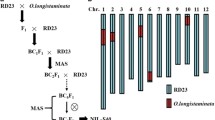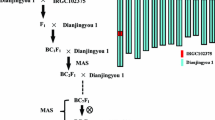Abstract
Hybrid sterility hinders the exploitation of the heterosis displayed by japonica × indica rice hybrids. The variation in pollen semi-sterility observed among hybrids between the japonica recipient cultivar and each of two sets of chromosome segment substitution lines involving introgression from an indica cultivar was due to a factor on chromosome 5 known to harbor the gene S24. S24 was fine mapped to a 42 kb segment by analyzing a large F2 population bred from the cross S24-NIL × Asominori, while the semi-sterility shown by the F1 hybrid was ascribable to mitotic failure at the early bicellular pollen stage. Interestingly, two other pollen sterility genes (f5-Du and Sb) map to the same region (Li et al. in Chin Sci Bull 51:675–680, 2006; Wang et al. in Theor Appl Genet 112:382–387, 2006), allowing a search for candidate genes in the 6.4 kb overlap between the three genes. By sequencing the overlapped fragment in wild rice, indica cultivars and japonica cultivars, a protein ankyrin-3 encoded by the ORF2 was identified as the molecular base for S24. A cultivar Dular was found to have a hybrid-sterility-neutral allele, S24-n, in which an insertion of 30 bp was confirmed. Thus, it was possible to add one more case of molecular bases for the hybrid sterility. No gamete abortion is caused on heterozygous maternal genotype with an impaired sequence from the hybrid-sterility-neutral genotype. This result will be useful in understanding of wide compatibility in rice breeding.








Similar content being viewed by others
Abbreviations
- ANK-3:
-
Ankyrin-3
- CSSLs:
-
Chromosome segment substitution lines
- MMC:
-
Microspore mother cell
- NILs:
-
Near isogenic lines
- ORF:
-
Open reading frame
- SSR:
-
Simple sequence repeat
- WCG:
-
Wide compatibility gene
- WCV:
-
Wide compatibility variety
References
Bennett V, Chen L (2001) Ankyrins and cellular targeting of diverse membrane proteins to physiological sites. Curr Opin Cell Biol 13:61–67
Chen X, Temnykh S, Xu Y, Cho YG, McCouch SR (1997) Development of a microsatellite framework map providing genome-wide coverage in rice (Oryza sativa L.). Theor Appl Genet 95:553–567
Chen JJ, Ding JH, Ouyang YD, Du HY, Yang JY, Cheng K, Zhao J, Qiu SQ, Zhang XL, Yao JL, Liu KD, Wang L, Xu CG, Li XH, Xue YB, Xia M, Ji Q, Lu JF, Xu ML, Zhang QF (2008) A triallelic system of S5 is a major regulator of the reproductive barrier and compatibility of indica–japonica hybrids in rice. Proc Natl Acad Sci USA 105:11436–11441
Feng JH, Lu YG, Liu XD, Xu XB (2001) Pollen development and its stages in rice (Oryza sativa L.). Chin J Rice Sci 1:21–28
Friesen J, Fleige T, Gross U, Bohne W (2008) Identification of novel bradyzoite-specific toxoplasma gondii genes with domains for protein-protein interactions by suppression subtractive hybridization. Mol Biochem Parasitol 157:228–232
Ikehashi H (2000) Hybrid sterility in rice—its genetics and implication to differentiation of cultivated rice. In: Nanda JS (ed) Rice breeding and genetics: research and challenges. Science Publishers, Enfield, pp 109–118
Ikehashi H (2009) Why are there indica type and japonica type in rice?—history of the studies and a view for origin of two types. Rice Sci 16:1–13
Ikehashi H, Araki H (1986) Genetics of F1 sterility in remote crosses of rice. In: IRRI (ed) Rice genetics. IRRI, Manila, pp 119–130
Jankowska AH, Czogalla A, Bok E, Sikorski AF (2002) Ankyrins, multifunctional proteins involved in many cellular pathways. Folia Histochem Cytol 40:239–249
Ji Q, Lu JF, Chao Q, Zhang Y, Zhang MJ, Gu MH, Xu ML (2010) Two sequence alterations, a 136 bp indel and an A/C polymorphic site, in the S5 locus are associated with spikelet fertility of indica–japonica hybrid in rice. J Genet Genomics 37:57–68
Jing W, Zhang WW, Jiang L, Chen LM, Zhai HQ, Wan JM (2007) Two novel loci for pollen sterility in hybrids between the weedy strain Ludao and the japonica variety Akihikari of rice (Oryza sativa L.). Theor Appl Genet 114:915–925
Kovach MJ, Sweeney MT, McCouch SR (2007) New insights into the history of rice domestication. Trends Genet 23:578–587
Kubo T, Aida Y, Nakamura K, Tsunematsu H, Doi K, Yoshimura A (2002) Reciprocal chromosome segment substitution series derived from japonica and indica cross of rice (Oryza sativa L.). Breed Sci 52:319–325
Kubo T, Yamagata Y, Eguchi M, Yoshimura A (2008) A novel epistatic interaction at two loci causing hybrid male sterility in an inter-subspecific cross of rice (Oryza sativa L.). Genes Genet Syst 83:443–453
Lander ES, Green P, Abrahamson J, Barlow A, Daly MJ, Lincoln SE, Newburg L (1987) MAPMAKER: an interactive computer package for constructing primary genetic linkage map of experimental and natural populations. Genomics 1:174–181
Li WT, Zeng RZ, Zhang ZM, Ding XH, Zhang GQ (2006) Fine mapping of locus S-b for F1 pollen sterility in rice (Oryza sativa L.). Chin Sci Bull 51:675–680
Li DT, Chen LMJL, Zhu SS, Zhao ZG, Liu SJ, Su N, Zhai HQ, Ikehashi H, Wan JM (2007) Fine mapping of S32(t), a new gene causing hybrid embryo sac sterility in a Chinese landrace rice (Oryza sativa L.). Theor Appl Genet 114:515–524
Li WT, Zeng RZ, Zhang ZM, Ding XH, Zhang GQ (2008) Identification and fine mapping of S-d, a new locus conferring the partial pollen sterility of intersubspecific F1 hybrids in rice (Oryza sativa L.). Theor Appl Genet 116:915–922
Liu YS, Zhu LH, Sun JS, Chen Y (2001) Mapping QTLs for defective female gametophyte development in an inter-subspecific cross in Oryza sativa L. Theor Appl Genet 102:1243–1251
Long YM, Zhao LF, Niu BX, Su J, Wu H, Chen YL, Zhang QY, Guo JX, Zhuang CX, Mei MT, Xia JX, Wang L, Wu HB, Liu YG (2008) Hybrid male sterility in rice controlled by interaction between divergent alleles of two adjacent genes. Proc Natl Acad Sci USA 105:18871–18876
Lu CG, Zou JS, Ikehashi H (2004) Developing rice lines possessing neutral alleles at sterility loci to improve the width of compatibility. Plant Breed 123:98–100
Mosavi LK, Minor DL, Peng ZY (2002) Consensus-derived structural determinants of the ankyrin repeat motif. Proc Natl Acad Sci USA 99:16029–16034
Mosavi LK, Cammett TJ, Desrosiers DC, Peng ZY (2004) The ankyrin repeat as molecular architecture for protein recognition. Protein Sci 13:1435–1448
Nagata K, Fukuta Y, Shimizu H, Yagi T, Terao T (2002) Quantitative trait loci sink size and ripening traits in rice (Oryza sativa). Breed Sci 52:259–273
Oka HI (1974) Analysis of genes controlling F1 sterility in rice by the use of isogenic lines. Genetics 77:521–534
Ouyang YD, Liu YG, Zhang QF (2010) Hybrid sterility in plant: stories from rice. Curr Opin Plant Biol 13:186–192
Rick CM (1966) Abortion of male and female gametes in the tomato determined by allelic interaction. Genetics 53:85–96
Shen YJ, Jiang H, Jin JP, Zhang ZB, Xi B, He YY, Wang G, Chen Wang, Qian LL, Li X, Yu QB, Liu HJ, Chen DH, Gao JH, Huang H, Shi TL, Yang ZN (2004) Development of genome wide DNA polymorphism database for map-based cloning of rice genes. Plant Physiol 135:1198–1205
Smith JM (1989) Evolutionary genetics. Oxford University Press, Oxford, pp 272–304
Wan J, Ikehashi H (1995) Identification of a new locus S-16 causing hybrid sterility in native rice varieties (Oryza sativa L.) from Tai-hu lake region and Yunnan province, China. Breeding Sci 45:161–170
Wan J, Yanagihara S, Kato H, Ikehashi H (1993) Multiple alleles at a new locus causing hybrid sterility between a Korean indica variety and japonica variety in rice. Japan J Breed 43:507–516
Wan J, Yamaguchi Y, Kato H, Ikehashi H (1996) Two new loci for hybrid sterility in cultivated rice (Oryza sativa L.). Theor Appl Genet 92:183–190
Wang J, Liu KD, Xu CG, Li XH, Zhang QF (1998) The high level of wide-compatibility of variety ‘Dular’ has a complex genetic basis. Theor Appl Genet 97:407–412
Wang GW, He YQ, Xu CG, Zhang QF (2006) Fine mapping of f5-Du, a gene conferring wide-compatibility for pollen fertility in inter-subspecific hybrids of rice (Oryza sativa L.). Theor Appl Genet 112:382–387
Wang Y, Zhong ZZ, Zhao ZG, Jiang L, Bian XF, Zhang WW, Liu LL, Ikehashi H, Wan JM (2010) Fine mapping of a gene causing hybrid pollen sterility between Yunnan weedy rice and cultivated rice (Oryza sativa L.) and phylogenetic analysis of Yunnan weedy rice. Planta 231:559–570
Win KT, Kubo T, Miyazaki Y, Doi K, Yamagata Y, Yoshimura A (2009) Identification of two loci causing F1 pollen sterility in inter- and intraspecific crosses of rice. Breed Sci 59:411–418
Yamagata Y, Yamamoto E, Aya K, Win KT, Doi K, Sobrizal, Ito T, Kanamori H, Wu JZ, Matsumoto T, Matsuoka M, Ashikari M, Yoshimura A (2010) Mitochondrial gene in the nuclear genome induces reproductive barrier in rice. Proc Natl Acad Sci USA 107:1494–1499
Yanagihara S, Kato H, Ikehashi H (1992) A new locus for multiple alleles causing hybrid sterility between an aus variety and javanica varieties in rice (Oryza sativa L.). Japan J Breed 42:793–801
Yu CY, Wan JM, Zhai HQ, Wang CM, Jiang L, Xiao YH, Liu YQ (2005) Study on heterosis of inter-subspecies between indica and japonica rice (Oryza sativa L.) using chromosome segment substitution lines. Chin Sci Bull 50:131–136
Yuan LP (1992) The strategy of the development of hybrid rice breeding. In: Yuan LP (ed) Current status of two line hybrid rice research, vols 1–5. Agricultural Publishing Ltd, Beijing (in Chinese, English summary)
Zhang QF, Liu KD, Yang GP, Saghai Maroof MA, Xu CG, Zhou ZQ (1997) Molecular marker diversity and hybrid sterility in indica–japonica rice crosses. Theor Appl Genet 95:112–118
Zhao ZG, Jiang L, Zhang WW, Yu CY, Zhu SS, Xie K, Tian H, Liu LL, Ikehashi H, Wan JM (2007) Fine mapping of S31, a gene responsible for hybrid embryo-sac abortion in rice (Oryza sativa L.). Planta 226:1087–1096
Zhu SS, Jiang L, Wang CC, Zhai HQ, Li DT, Wan JM (2005) The origin of a Weedy rice Ludao in China deduced by a genome wide analysis of its hybrid sterility genes. Breed Sci 55:409–414
Acknowledgments
We thank Dr. A. Yoshimura (Kyushu University, Japan) for his kind provision of the CSSL populations and associated genotypic data. This research was supported by the Grants from the Chinese National High Technology Research and Development Program (“863” Program, Nos. 2001AA241024; 2003AA222131; 2003AA207020), the Chinese National Natural Science Foundation (30800679) and the “948” project.
Author information
Authors and Affiliations
Corresponding author
Electronic supplementary material
Below is the link to the electronic supplementary material.
Supplement Table 1 Nucleotide variation within the S24 sequence in a panel of 14 O. rufipogon accessions and 13 indica cultivars and 11 Japonica cultivars
Supplement Table 2 Primer sequences used to amplify de novo developed molecular markers and re-sequenced are listed
Supplement Fig. 1 Breeding scheme for S24-NIL. CSSL34 includes IR24 segments of chromosomes 4, 5, 6 and 8 in an otherwise Asominori background. The black bars denote segments inherited from IR24
Supplement Fig. 2 Phylogenetic tree of the S24 gene created by the unweighted pair-group method using arithmetic average. Numbers indicate genetic distance in the phylogeny
Rights and permissions
About this article
Cite this article
Zhao, Z.G., Zhu, S.S., Zhang, Y.H. et al. Molecular analysis of an additional case of hybrid sterility in rice (Oryza sativa L.). Planta 233, 485–494 (2011). https://doi.org/10.1007/s00425-010-1313-8
Received:
Accepted:
Published:
Issue Date:
DOI: https://doi.org/10.1007/s00425-010-1313-8




